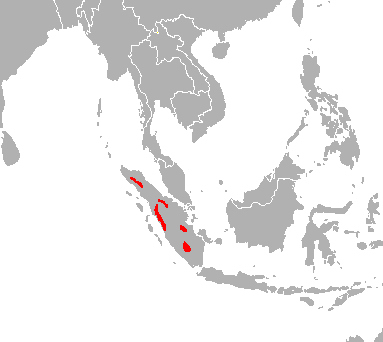
Habitat

Figure 1. Scatter map of Sumatran Tiger Populations.
Panthera tigris sumatrae is a unique species because it is only endemic to the Indonesian island of Sumatra (Dacres 2007). Sumatra is a small tropical island that is located in the Pacific Ocean northeast of Australia and consists mainly of rainforest. The species lives in clustered, isolated populations throughout the Sumatran terrain, alongside the Sumatran Orangutan (O’Brien et al. 2003). Many of these tigers live near the coast on the southwestern side of Sumatra, where there is minimal human interaction and deforestation (Sunarto et al. 2012).
Conditions must be definite in order for these tigers to set up camp along the coast. There must be a water source, as most of the water in the ecosystems were lost as a result of deforestation (Sunarto et al. 2012). They also prefer the southwest side of Sumatra because the sub canopy is greater in size than regular forests, which offers more camouflage for hunting prey. With debris of previous foliage and trees covering the floor of its habitat, it is an optimal place for Sumatran Tigers to hunt its foraging prey (Linkie and Ridout 2011).
Also, with part of the upper canopy cleared, sunlight allows for more secondary growth of flora, which in turn increases food availability for these Sumatran tigers (Linkie et al. 2008). Unfortunately, the continuous efforts of many companies to tear down rainforests is one of the main factors of the endangerment of Sumatran Tiger. As of late, there has been a steady annual decrease in habitat (Sunarto et al. 2012). If this deforestation is left unchecked, the area of suitable land for the Sumatran Tiger to hunt will likely decrease, leading to the extinction of the species. Even though there are a handful of nationally protected areas, much of the population density lies outside these regions (Sunarto et al. 2012). However, some of these tigers live in high altitude habitats, which is the most dangerous, due to the high visibility during the day time. An advantage to this habitat, however, is that there are less outside sources to hinder its growth (Sunarto et al. 2012).
In order to survive, Sumatran tigers that live in the mountains must wander from place to place and try to remain hidden. Those who live in the rainforests live within the shadows of the many species of flora (Sunarto et al. 2012). Sumatran tigers are inept to settling in rainforests because their dark fur color and low center of gravity allow them to maneuver between leaves and branches unseen. Also, the towering canopy provides shade for these tigers. As a result, tiger conserve water and energy for hunting prey. Within any habitat, Sumatran tigers keep a certain radii for hunting ground and avoidance of other tigers competing for resources (Imron et al. 2012). When conditions are unfavorable, they will instinctively wander outside their standard home range to another that is more abundant with prey (Imron et al. 2012).